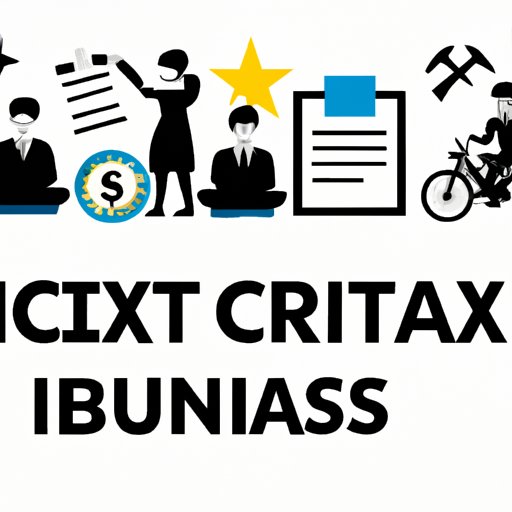Introduction
Business tax credits are a type of incentive offered by governments to encourage businesses to invest in specific activities, such as research and development, or hiring more employees. They offer a reduction in the amount of taxes owed to the government, allowing businesses to keep more of their profits. This article will explore the basics of business tax credits for start-ups, the requirements for qualifying, how to claim them, and what to consider when doing so.
Explaining the Basics of Business Tax Credits for Start-Ups
When starting a business, it is important to understand the different types of tax credits available, and the potential benefits they can offer. Generally, there are two types of business tax credits: refundable and nonrefundable. Refundable tax credits can be claimed even if the business does not owe any taxes; the government will simply issue a refund for the value of the credit. Nonrefundable tax credits can only be used to reduce the amount of taxes owed, up to the total amount of the credit.
The primary benefit of utilizing tax credits is the potential savings on taxes; however, there may also be additional advantages such as increased access to capital and improved cash flow. Additionally, some tax credits can be carried forward to future years, providing an ongoing benefit for the business.
How to Qualify for a Tax Credit When Starting Your Business
In order to qualify for a tax credit, businesses must meet certain criteria set by the government. These criteria vary depending on the type of credit being sought, but generally include factors such as size of the business, type of activity being undertaken, and number of employees. It is important to research the specific requirements for each credit to ensure that the business meets the necessary qualifications.
In addition to meeting the eligibility criteria, businesses must also provide documentation to support their claim. This may include financial statements, invoices, receipts, and other records demonstrating the activity being undertaken. The exact documents required depend on the type of credit being applied for and should be researched carefully to ensure all necessary information is provided.

A Guide to Claiming Tax Credits for New Businesses
Once a business has determined that they qualify for a tax credit, the next step is to submit a claim. This process varies depending on the jurisdiction, but typically involves completing a form and submitting it along with supporting documentation to the relevant government agency. It is important to note that there are usually strict deadlines for filing claims, so businesses should be aware of these and ensure that they are met.
In some cases, businesses may need to provide additional information after submitting their initial claim. This could include additional documentation or clarification of certain aspects of the claim. If this is the case, it is important to respond promptly to avoid delays in processing the claim.
What You Need to Know About Business Tax Credits for Start-Ups
Claiming tax credits can have a significant impact on a business’s overall financial health, both positively and negatively. On one hand, it can provide much needed relief from the costs associated with starting a business. On the other hand, it can be risky if the business does not meet the necessary criteria or fails to file the claim correctly. Additionally, businesses should be aware of any restrictions or limitations associated with the credits they are claiming, as these may affect their ability to take advantage of the incentives.
Navigating Tax Credits for Entrepreneurs: A Step-by-Step Guide
Claiming business tax credits can seem daunting, but it doesn’t have to be. By following a few simple steps, entrepreneurs can successfully navigate the process and reap the rewards. The first step is to research the different types of credits available and determine which ones may apply to the business. Next, check to see if the business meets the requirements for the credits and gather the necessary documentation. Finally, complete the application process and submit the claim before the deadline.
There are also a number of resources available to help entrepreneurs through the process. The Small Business Administration (SBA) provides information on federal tax credits, while state and local governments often have websites dedicated to outlining the available tax credits in their jurisdictions.
Conclusion
Business tax credits can be a valuable tool for entrepreneurs looking to reduce the costs associated with starting a business. However, it is important to understand the requirements for claiming the credits, as well as the potential risks involved. By following a few simple steps and utilizing the resources available, entrepreneurs can successfully navigate the process and make the most of the available tax credits.
(Note: Is this article not meeting your expectations? Do you have knowledge or insights to share? Unlock new opportunities and expand your reach by joining our authors team. Click Registration to join us and share your expertise with our readers.)
